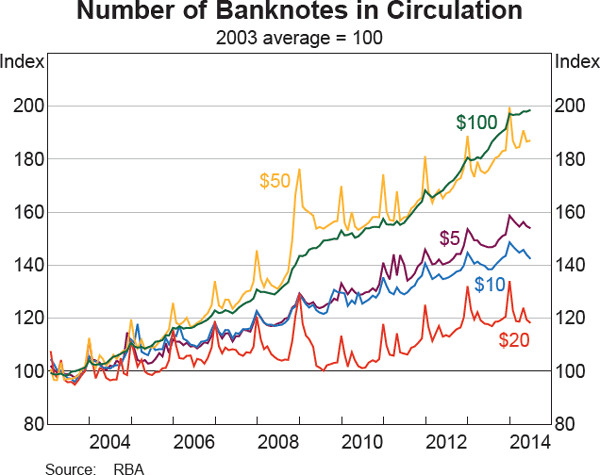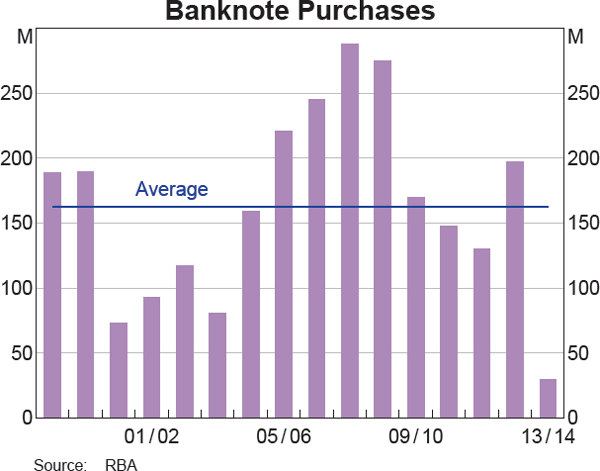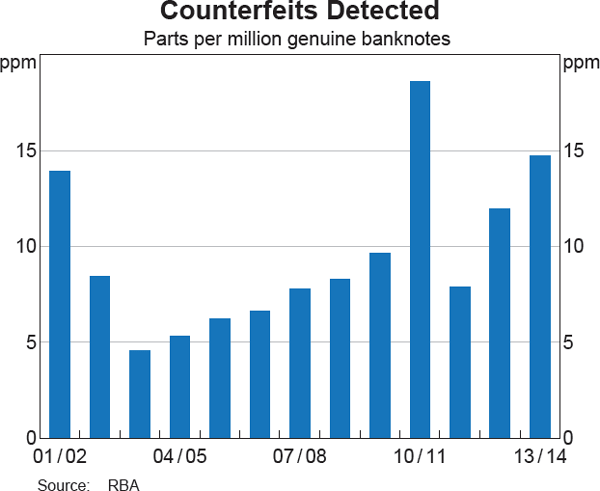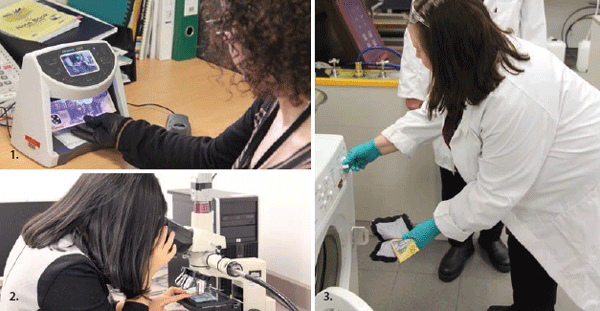Reserve Bank of Australia Annual Report – 2014 Banknotes
The Reserve Bank is responsible for ensuring that there are sufficient high-quality banknotes in circulation to meet public demand. This demand stems from the role of banknotes as a payment mechanism and store of wealth. To preserve public confidence in the capacity of banknotes to perform these roles, the Bank:
- issues sufficient banknotes to meet public demand
- maintains the quality of banknotes in circulation by withdrawing old, worn banknotes and replacing them with new banknotes
- conducts research and development to ensure that Australian banknotes remain secure against counterfeiting.
Banknotes on Issue
At the end of June 2014 there were 1.3 billion banknotes, worth $60.8 billion, in circulation. The value of banknotes in circulation increased by 7 per cent in 2013/14, slightly above the long-term growth rate of 6 per cent. This growth was driven by high-denomination banknotes, with the number of $100 banknotes increasing by 8 per cent in 2013/14 and the number of $50 banknotes increasing by over 6 per cent. Together, these banknotes accounted for 92 per cent of the value and 66 per cent of the number of banknotes in circulation at the end of 2013/14.
The number of $5 banknotes in circulation in 2013/14 increased by 5 per cent, which was also more than its long-term growth rate of 4 per cent, while growth in $10 and $20 banknotes in 2013/14 was below their respective long-term growth rates of 3 per cent and 2 per cent.
New Banknote Purchases
The Reserve Bank purchased 30 million banknotes from Note Printing Australia Limited (NPA) in 2013/14, considerably less than the 197 million banknotes purchased in 2012/13. This reflects the Bank's intention to reduce its contingency holdings of the current banknotes series in the lead up to the issuance of the new banknote series. All banknotes purchases from NPA in 2013/14 were of the $100 denomination.
Distribution
The Reserve Bank holds banknotes to accommodate the growth in the number of banknotes in circulation and seasonal fluctuations in demand, as well as for contingency purposes in the event of systemic shocks and production disruptions. The Bank has agreements with the commercial banks to enable them to access these banknotes. Commercial banks also maintain their own holdings of banknotes in their branches and cash-in-transit depots around Australia. The Reserve Bank issued banknotes worth $9.3 billion in 2013/14, of which $3.7 billion had previously been in circulation and $5.6 billion were new.


The Reserve Bank aims to maintain a high quality of banknotes in circulation to ensure public confidence in Australia's banknotes. High-quality banknotes reduce problems with machine acceptance and make it more difficult for counterfeits to be passed. For this reason, the Bank provides incentives to major commercial banks and their carriers to reissue fit banknotes into circulation and return those that are unfit to the National Note Processing and Distribution Centre (NNPDC), operated by NPA, where their authenticity and quality are confirmed. In 2013/14 the NNPDC received $2 billion worth of banknotes deemed unfit for recirculation.
The Reserve Bank also removes unfit banknotes from circulation through its Damaged Banknotes Facility. In January 2014, the Bank updated its Damaged Banknotes Policy, which governs whether and how damaged banknotes are assessed. Under the Policy, members of the public who have unwittingly come into possession of damaged banknotes or whose banknotes are accidentally damaged can ask the Bank to examine and verify their damaged or contaminated banknotes. Payment is then made, based on the assessed value of each claim. The Bank processed more than 15,000 claims and made $6.9 million in payments in 2013/14. This was a reduction from 2012/13, which was boosted by claims arising from floods in Queensland and New South Wales.
Counterfeiting in Australia
In 2013/14, a total of 18,657 counterfeits were detected in circulation, with a nominal value of $1,083,680. This corresponds to around 15 counterfeits detected per million genuine banknotes in circulation. The majority of counterfeits in 2013/14 were $50 and $100 banknotes. Although this represents an increase in counterfeiting activity from recent years, the level of counterfeiting remains low by international standards.
| $5 | $10 | $20 | $50 | $100 | Total | |
|---|---|---|---|---|---|---|
| Number | 16 | 45 | 440 | 14,825 | 3,331 | 18,657 |
| Nominal value ($) | 80 | 450 | 8,800 | 741,250 | 333,100 | 1,083,680 |
| Parts per million | 0.1 | 0.4 | 2.8 | 26.0 | 12.6 | 14.8 |
|
Source: RBA |
||||||
The Reserve Bank works closely with law enforcement agencies to monitor trends in counterfeiting and identify emerging counterfeiting threats. The Bank's Counterfeit Examination Laboratory, located in Craigieburn, Victoria, also assists police by providing counterfeit examination services, including preparing expert witness statements and court testimonies.

During 2013/14, the Bank conducted Counterfeit Deterrence Workshops in Melbourne and Perth in partnership with the Australian Federal Police. These workshops provided participants with an opportunity to discuss counterfeit deterrence initiatives as well as develop a broader understanding of banknote security features. Both workshops were well attended by a broad cross-section of organisations, including the Australian Federal and State Police, cash-in-transit companies, financial institutions, casinos and retailers.
Next Generation Banknote (NGB) Project
While Australia has experienced relatively low levels of counterfeiting – both in absolute terms and compared with other countries – the Reserve Bank has an ongoing commitment to ensure that Australia's counterfeiting level remains low into the future. As a part of this commitment, in 2012 the Bank announced plans to upgrade the security features on Australia's banknotes as part of the NGB project.
The current series has been in circulation for around 20 years, whereas many countries tend to upgrade their banknotes every seven to ten years. The longevity of the current series is a direct payoff from the investment made in developing polymer banknotes, which have been a key contributor to Australia's low counterfeiting rates.
Since the project to upgrade the security of Australia's banknotes was established in 2007, considerable work has been undertaken, including the development, testing and review of banknote designs and production trials of new security features. While the new banknotes will retain many of the key design elements of the current banknote series, including the people portrayed, size, general colour palette and denominational structure, there will be design changes to accommodate new security features. The Reserve Bank has consulted extensively with key users of banknotes, including banknote equipment manufacturers, retail organisations, financial institutions and the vision-impaired community. These ongoing consultations provide an opportunity to ensure that the new banknotes will continue to meet the various needs of the whole community.
It is anticipated that it will be several years before the full series of upgraded banknotes will be issued into circulation, with the issuance of the denominations staged across a number of years. The time required to complete the project reflects the complexity of the process of designing and producing a new banknote, extensive community consultation and the need to make sure that the design produces a secure, functional and durable banknote.
As at the end of June 2014, $16.6 million had been spent on design, development and testing. This investment will help maintain the security of Australia's banknotes.
Banknote Infrastructure Modernisation Project
In preparation for the logistical demands arising from the introduction of a new series of banknotes, the Reserve Bank has begun work to upgrade its existing banknote infrastructure. The main objectives of the upgrade are to increase banknote storage and processing capacity, and to introduce new technologies and systems to improve banknote logistics processes and simplify distribution arrangements with the cash-in-transit companies. The upgrade will include the construction of the National Banknote Site (NBS), which will be built on the Bank's existing Craigieburn property to accommodate the storage, processing and distribution functions of the banknote operation. The new two-storey building was approved by the Parliamentary Public Works Committee in March 2014, with a budget of $72 million, and is scheduled for completion in 2017.
The Reserve Bank is also undertaking a banknote logistics improvement program that will simplify manual processes in the Bank's existing sites and introduce automated processes at the NBS. This will allow for more efficient workflows and a reduction in work health and safety risks, and further improve the security associated with the handling of banknotes. The program will also enhance the Bank's existing information technology systems. In parallel, the Bank will increase its capacity to process unfit banknotes through the purchase of two additional high-speed banknote processing machines.
Banknote Research and Development
The Research and Development program conducted by the Reserve Bank aims to ensure that Australian banknotes remain both secure against counterfeiting and functional for a wide variety of users. Innovative new technologies that can help achieve this objective are identified and developed into new security features for banknotes through a range of collaborations with third parties, including universities, public and private companies, research institutes and other central banks. The Bank also contributes to several international forums concerned with banknote security, including the Central Bank Counterfeit Deterrence Group, which examines emerging threats in counterfeiting technologies, and the Reproduction Research Centre, which provides facilities to test anti-counterfeiting technologies.

Located in the NPA building in Craigieburn, Victoria, the Research and Development section works closely with the Reserve Bank's partners and suppliers to introduce new technologies and features into the banknote production process. The staff also provide extensive technical services in the areas of finished banknote quality assurance, assessment of damaged banknotes and the evaluation of suspected counterfeit banknotes.
In 2013/14, the research program focused heavily on the development of the NGB series, conducting extensive trialling to ensure the new features are secure and durable, along with the development of new testing methodologies that will form part of the quality assurance program.
Community Liaison
The Reserve Bank actively consults and liaises with a broad range of stakeholders, which includes users and manufacturers of banknote equipment, representative groups from the vision-impaired community, law enforcement agencies, retail organisations, schools and financial institutions. More than 110 presentations were made to these groups during 2013/14, with the aim of increasing knowledge about banknotes in the community and, in some cases, receiving feedback.
The Reserve Bank's banknotes microsite continues to play an important role in providing information about banknotes to the general public and has been updated to include additional activities for younger audiences.
An online school education resource aimed at educating primary school students about Australia's banknotes was also developed as a collaborative project between the New South Wales Department of Education and Communities and the Reserve Bank. The resource, which provides engaging and interactive information about banknotes through history and mathematics activities aligned to the Australian curriculum as well as comprehensive teaching notes, is expected to be launched later in 2014.
Numismatic Banknote Sales
The Reserve Bank conducted numismatic banknote sales in July and August 2014 for all denominations of banknotes produced in 2013. These banknotes were sold to the public at set prices during a six-week sale period.
Note Printing Australia Limited (NPA)
NPA is a wholly owned subsidiary of the Reserve Bank that produces banknotes and operates the NNPDC on behalf of the Bank. NPA operates under a charter reviewed and approved annually by the Reserve Bank Board. Specifically, NPA's prime function is the efficient and cost-effective production of high-quality and secure Australian banknotes, in accordance with the specifications and requirements of the Bank. The charter also permits NPA to undertake other activities, including developing and producing passports for the Department of Foreign Affairs and Trade (DFAT), producing banknotes for other issuing authorities and producing some other security products. In recent years, these activities have included the production of banknotes for some countries in the Asia-Pacific region. In all cases, NPA dealt directly with the relevant central banks.
NPA is governed by a Board of Directors appointed by the Reserve Bank. As at 30 June 2014, the Board comprised four Bank executives and a member of the Reserve Bank Board: Michele Bullock, Assistant Governor (Currency) as Chair; Keith Hall, Assistant Governor (Banking and Payments); Lindsay Boulton, Head of Banking Department; Michelle McPhee, Head of Risk and Compliance Department; and Heather Ridout AO, a member of the Reserve Bank Board. The NPA Board has an Audit and Risk Committee, whose membership comprises Keith Hall (Chair), Lindsay Boulton and an external member, Alan Beckett, a company director and former senior audit partner of a major accounting firm with extensive experience in the corporate sector, including manufacturing.
In late June 2014, NPA's Chief Executive Officer, Bernhard Imbach, resigned to take up a position elsewhere in the industry. The NPA Board appointed NPA's Chief Financial Officer, Malcolm McDowell, as Acting Chief Executive Officer until such time as the Board appoints a new chief executive. Six business units report to NPA's Chief Executive Officer: Financial Services, Manufacturing Operations, Passports Business and Support Services, Quality Management, Risk Management and Security, and Human Resources. The Chief Executive Officer and the heads of these business areas constitute NPA's Executive Committee. As at the end of June 2014, NPA employed 225 permanent staff.
In 2013/14, NPA delivered 30.1 million Australian banknotes to the Reserve Bank under a contract entered into in 2011. NPA also provided banknote distribution and banknote processing services to the Bank during the year, under a contract entered into in 2001. The aggregate amount paid by the Bank to NPA in 2013/14 for the supply of banknotes and related services under the above contracts was $48.9 million. The Reserve Bank Board did not take any decisions in 2013/14 in relation to these two supply contracts between NPA and the Bank.
In addition, NPA delivered 141.4 million banknotes to other countries in 2013/14, including Brunei, New Zealand and Papua New Guinea. NPA also produced 1.2 million passports for DFAT during the year in review, including 0.8 million of the new P series passports introduced in June 2014.
The financial accounts of NPA are consolidated with those of the Reserve Bank.